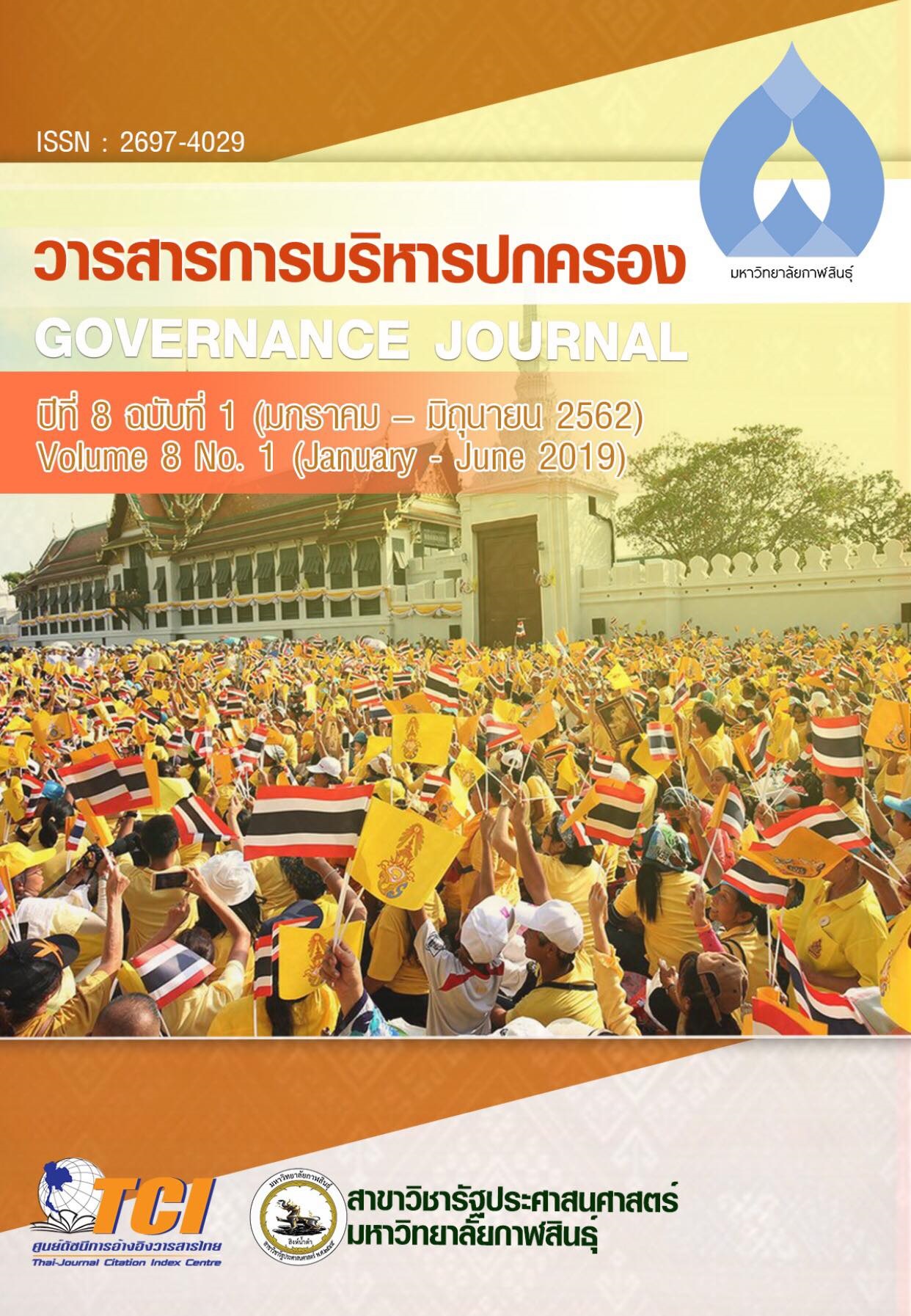Retention of Talented Personnel in the New Medical Schools in Northeastern Thailand
Keywords:
Retention, Talent, New Medical SchoolsAbstract
Abstract
The objectives of this research to study the significant factors and the development ways, there were doctoral staff retention in new Medical Schools in the northeast. The interviewee involved 38 medical staffs, administrators and Professionals of the selected institutions, the in-depth interview also comprehended through semi-structured questions and conducted the non-participant observation, then all was checked by methodological triangular. Furthermore, this research composed the data of the documents and websites. The results found that the medical staff retention, the administrator should attend to the value and always listen everyone’s opinion, also clarify the work system based on the efficiency evaluation, at the same time, human resource development should be developed and cooperated other organizations, moreover, the salary and welfare issue is adjusted precipitately. Furthermore, the management can be flexible according to the conditions and real situations. Therefore, the administrator should be reasonable and tolerant, also honor and build good interaction with everyone.
Downloads
References
นิลเนตร วีระสมบัติ. (2552). การคงอยู่ของแพทย์ในโรงพยาบาลชุมชนของ
ประเทศไทย. (Online) สืบค้นจาก http://libdcms.nida.ac.th/thesis6/2552/b166478.pdf, เข้าถึงเมื่อวันที่ 7 กรกฎาคม 2560.
ปฐมพงษ์ โตพานิชสุรีย์. (2553). การรักษาผู้มีผลสัมฤทธิ์สูงในองค์กร: กรณีศึกษา
ข้าราชการพลเรือนสามัญ. วารสารบริหารธุรกิจ, 33(127): 35-49.
แพทยสภา. (2555). เกณฑ์ว่าด้วยการขอเปิดดำเนินการ/ปรับปรุงหลักสูตร
แพทยศาสตร์บัณฑิต. (Online) สืบค้นจาก
https://www.tmc.or.th/news_file/36-2555-22-06-55.pdf, เข้าถึงเมื่อวันที่ 30 มีนาคม 2560.
รายงานทรัพยากรสาธารณสุข สำนักนโยบายและยุทธศาสตร์ กระทรวงสาธารณสุข.
(2560). จำนวนประชากรต่อบุคลากรทางการแพทย์ 1 คน จำแนกรายภาค ปี พ.ศ. 2547 – 2559 รายปี. สืบค้นเมื่อวันที่ 1 สิงหาคม 2561 จาก http://social.nesdb.go.th/SocialStat/StatReport_Final.aspx?
reportid=663&template=1R2C&yeartype=M&subcatid=18
วรรษพร อากาศแจ้ง. (2556). ปัจจัยที่ส่งผลต่อความตั้งใจลาออกของคนเก่งในระบบ
ราชการ. วารสารการจัดการ มหาวิทยาลัยวลัยลักษณ์, 2(2): 47-58.
อรุณวดี นันทวัฒนานุกูล, พรรัตน์ แสดงอาจ และอภิญญา อิงอาจ. โมเดลการบริหาร
จัดการคนเก่ง คนดี ของสถานประกอบการอุตสาหกรรมไฟฟ้าและอิเล็คทรอนิคส์. วารสารการจัดการธุรกิจ มหาวิทยาลัยบูรพา คณะการจัดการและ
การท่องเที่ยว, 4(1): 55-71
อิงครัตน์ สีเขียวสุขวงกฎ. (2559). ปัจจัยที่มีอิทธิพลต่อการลาออกของแพทย์ในระบบ
ราชการของโรงพยาบาลในประเทศไทย. วารสารบัณฑิตศึกษา
มนุษยศาสตร์สังคมศาสตร์ มหาวิทยาลัยขอนแก่น, 5(1): 183-209
Adzei, F. A., & Atinga, R. A. (2012). “Motivation and Retention of Health
Workers in Ghana’s District Hospitals: Addressing the Citical Issues.” Journal of Health Organization and Management 26(4). Retrieved from https://www.ncbi.nlm.nih.gov/pubmed/23115900,
July 7, 2017.
Braun, V. & Clarke, V. (2006). Using Thematic Analysis in Psychology.
Qualitative Research in Psychology, 3 (2), 77-101. Retrieved from http://eprints.uwe.ac.uk/11735/2/Thematic
_analysis_revised_-_final.pdf
Berger, L. A., & Berger, D. R. (2004). The Talent Management
Handbook: Creating Organizational Excellence by Identify, Developing and Promoting Your Best People. New York: McGraw- Hill.
Dyk, J., Coetzee, M., & Takwira, N. (2013). Statisfaction with retention
factors as predictors of the job embeddedness of medical and information technology services staff. Southern African Business Review, 17(1), 57-75.
Ezzedeen, S. R. & Ritchey, K. G. (2009). Career Advancement and Family
Balance Strategies of Executive Woman. Gender in Management: An International Journal, 24(6): 388-411.
Lawler, E. E. (2009). Make Human Capital a Source of Competitive
Advantage. Los Angeles, CA: Center for Effective Organization.
Lawler, E. E., & Jenkins D. G. (1992). Strategic Reward Systems. Los
Angeles, CA: Center for Effective Organization.
Lockwood, N. R. (2006). “Talent management: Driver for Organizational
Success.” HR Magazine 51(6). Retrieved from https://www.shrm.org/Research/Articles/Articles/
Documents/0606RQuartpdf.pdf, July 27, 2017
McGuire, M., Houser, J., Jarrar, T., Moy, W., & Wall, M. (2003). “Retention:
It's All About Respect.” The Health Manager 22(1). Retrieved from https://journals.lww.com/health
care managerjournal/Abstract/2003/01000/Retention It_s_All_About_Respect.7.aspx, July 7, 2017.
Newman, Isadore & Benz, Carolyn R. (1998). Qualitative-quantitative
Research Methodology: Exploring the Interactive Continuum. Carbondale and Edwardsville: Southern Illinois University Press.
Samuel, M. O., & Chipunza, C. (2009). Employee Retention and
Turnover: Using Motivational Variables as a Panacea. African Journal of Business Management, 3(8): 410-415.
Zeffane, R., & Connell, J. (2003). Trust and HRM in the New Millennium.
International Journal of Human Resource Management, 1 4(1): 3-11.
Translated Thai References
Arkardjang, W. (2013). Factors that affect the intention of talents to
leave the bureaucracy. WMS Journal of Management, 2(2),
47-58.
Report on Public Health Resources. Bureau of Policy and Strategy.
Ministry of Public Health. (2017). Number of individual
medical personnel to the population from 2004 to 2016 per
year. Retrieved fromhttp://social.nesdb.go.th/SocialStat/
StatReport_Final.aspx?reportid=663&template=1R2C&yeartype=
M&subcatid=18
Sikheawsukwongkot, I. (2559). Factors Turnover of Physicians in Thai
Public Hospitals. Journal of Graduate Study in Humanities
and Social Sciences, 5 (1): 183- 209.
The Medical Council of Thailand. (2012). Basic Medical Education
WFME Global Standards for Quality Improvement. Retrieved from https://www.tmc.or.th/
news_file/36-2555-22-06-55.pdf
Tophanitchsuree, P. (2010). Talent retention: A case study of civil
servants. Journal of Business Administration, 33 (127), 35-49.
Virasombat, N. (2009). Physician retention in community hospitals of
Thailand. Retrieved May 25, 2017 from http://libdcms.nida.ac.th/thesis6/2552/b166478.pdf
Nantawatananukul, A., Sadaenghan, P., & Ing-art, A. (2015). The Talent
Management Model in Electrical and Electronics Industry Companies. Burapha Journal of Business
Management, 4 (1): 55-71






